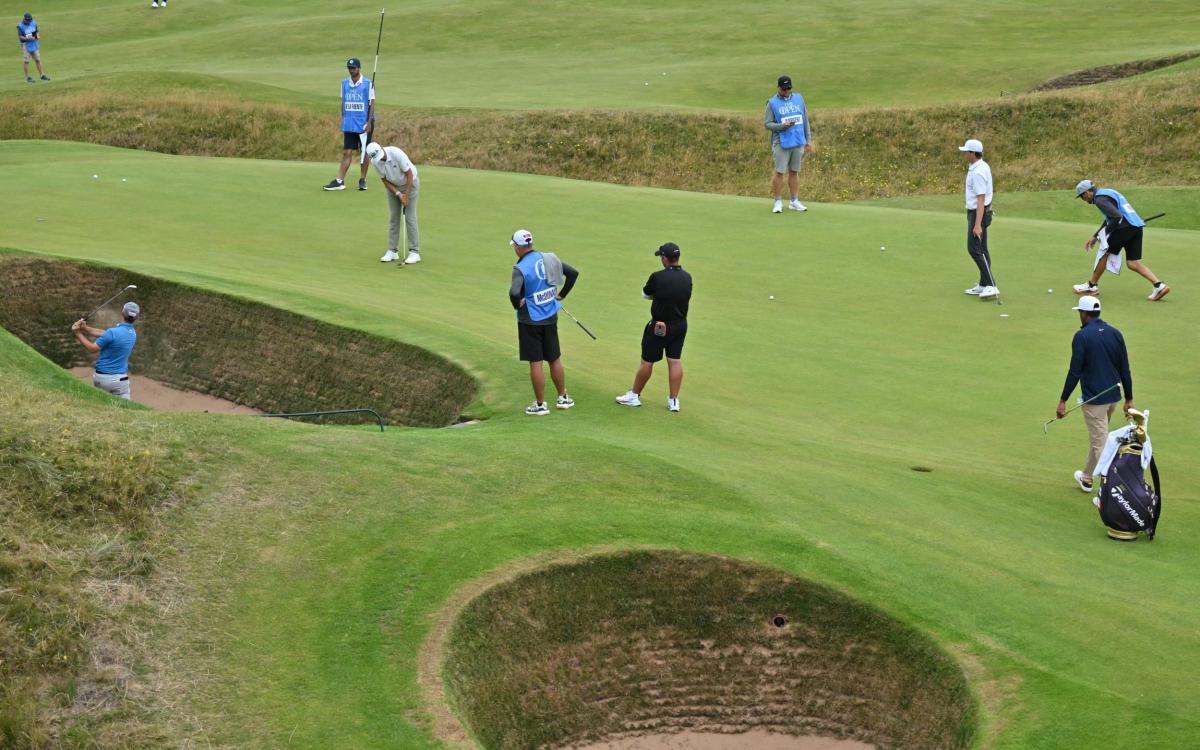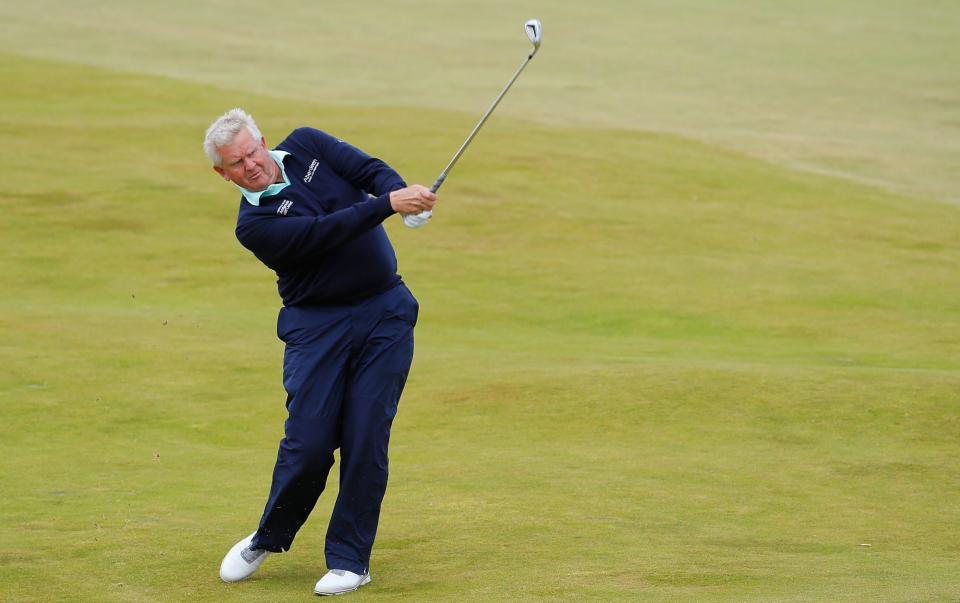I played Troon’s famous postage stamp – you shouldn’t do that


“It’s 123 yards from tee to green, but with the wind it’s probably only about 90 yards,” my caddy Brian advised me as we approached the 8th tee at Troon on a blustery April day.
Ninety yards? Anyone unfamiliar with Royal Troon’s 8th hole – also known as the “Postage Stamp,” the shortest hole in the Open – will no doubt scoff at its fearsome reputation. How difficult can it be to land a ball on a putting area, no matter how small, from that ridiculous distance?
That can be pretty intense, especially when the wind is blowing, which it certainly can in these parts. Just ask Tiger Woods, who was in contention for the 1997 Open after shooting a 64 on Saturday but then 6-ing on a hole known locally as the “Wee Beastie.” Or any number of other unfortunate souls over the years.
In 1950, German amateur Hermann Tissies played the Postage Stamp in an incredible 15 strokes. It took him five strokes to get out of one of the bunkers guarding the green and he finished with a three-putt, as is the case with 15 strokes on a hole.
Would I rather be Tissies or Gene Sarazen, I wondered as I prepared my tee shot, the wind whipping over my left shoulder – unusually for Troon, the prevailing wind on the front nine holes usually blows from behind, and only the 8th hole is directed from behind.
Sarazen hit a famous ace at the Postage Stamp in his penultimate appearance at the 1973 Open at the age of 71. And the American star is far from the only player to have scored a hole-in-one there.
Because that is what is so special about the stamp – officially called Ailsa because the slightly elevated tee offers a perfect view of the rocky island of that name, but generally known by its nickname after a 1923 Golf illustrated The article described the green, embedded in the side of a sand hill, as “a playing field reduced to the size of a postage stamp” – on any given day it can be the scene of the sublime and the ridiculous.
Find the putting surface and you could walk away with a birdie. Miss it and you’ll be in big trouble. The five sand bunkers include a deep, rectangular one guarding the left edge, known rather ominously as “The Coffin.” “Because if you go in there, you’re dead,” Brian helpfully explained.
This year, the Postage Stamp could be even more spectacular. The R&A issued a statement in April suggesting that if the weather was good, it could be as short as 99 yards during one of the rounds, making it the shortest hole ever played in a British major.
A front pin and a front tee area with rigid cross ventilation would give an even more intimate atmosphere to the 1,500 spectators crammed into the newly constructed L-shaped grandstand.
So how did I get on? Reader, I was more of a wimp than a Saracen.
With Brian’s final words of advice ringing in my ears – “Aim slightly left towards the coffin and it should drift back” – I forced my hands to the left and spun the ball even further left. It found the slope between the two bunkers on the left and rolled it down and away from the green into the rough.
Things only got worse from there. I hit what seemed like a decent blind chip over the edge. But when I climbed up to see where my ball had landed, I found that it had rolled to the other side of the green, to the right of the hole.
Luckily, I had narrowly avoided the bunker that Rory McIlroy once took six shots to escape from during a practice round in 2016. Unfortunately, I botched my next chip, so paranoid was I that I might get caught in a back-and-forth volleyball game, and the ball barely made it onto the green.
From there, following Tissie’s lead, I took three putts and walked off the course with a 6, suitably contrite but looking forward to watching the pros try to tame Wee Beastie in July.
How to play the stamp
By James Corrigan
Bees sting bears. That’s a fact the giants of the sport at the 152nd Open Championship should keep in mind as they head to the par-3 8th hole at Royal Troon and suffer defeat at the Postage Stamp.
“It’s a dream destroyer, a card destroyer, an Open destroyer and it’s awesome,” says Colin Montgomerie, the Ayrshire town’s most famous son of golf. The evidence of this can be found throughout the course’s history. In 2016, the field played the hole over par on all four days, with the weekend’s rounds producing 32 bogeys and six double bogeys with 23 birdies.
In 1997, Tiger Woods described the challenge as “easy enough.”
“Hit the green – good,” said Woods. “Missed the green – bad.”
Montgomerie believes there is more to this than that. In fact, a test so heavily influenced by the wind can be seen as the result of a perfect storm in golf.
“First of all, there’s position in the Troon test,” Montgomerie said. “It’s the first hole that leads to victory. The first seven holes are into the wind. Ball position, the way you hit the ball, the way you think, how the wind reacts, everything has to do with hitting into the wind.”
“But then suddenly: ‘Bingo!’ Everything has changed compared to the last 90 minutes. What do you do now? You take the ball back into the stance, change the way you approach the ball, you try to hit the ball downwards. The feeling is completely different. So you pull it to the left or push it to the right. That’s the first mistake you make.”
And then there’s the visual itself. “You’re standing on an elevated tee and you’re looking at this narrow strip of green. My God, it’s narrow,” Montgomerie says. “And you say to yourself, ‘Come on, it’s 120 yards, you’re a pro, all these people are watching and this is just a small shot.’ But the more you look, the bigger these bunkers get and that’s the problem. Because this isn’t a case of ‘so what, just go up and down out of a bunker.’ My goodness, anything but that.”
The traps on the right are difficult enough – “from there you see bunker shots flying over the green into another bunker,” Montgomerie said – but on the left is the “coffin bunker.”
“Why do you think they call it that?” he added. “Not because it’s a damn fine place to rest, I can assure you. I played there recently and they’ve deepened the coffin and even if it’s only 18 inches it makes a big difference. You see five now instead of two, even more.


“It’s a mental thing and a technical thing and they’ve added stands this time which make it look more closed and increase the feeling of tightness. It’s a little beauty but it can and will be cruel if you don’t execute it. The Postage Stamp is one of the great par 3s, if not the best, and a prime example of why this sport shouldn’t just be about length.”
To emphasize this point, two holes before that is the sixth hole, which at 557 meters is the longest hole in the history of the Open.
“How about this? You might see the same player after a 550-metre run being happy with a four, and 20 minutes later you might see him after a 90-metre run being happy with a four after his tee shot landed there,” Montgomerie said. “It’s a unique setup and Troon likes it. But they’ve moved the tee shot back and I think it’s a shame that they have to keep expanding these classic courses because the ball goes so far.
“And for what? It’s 600 yards, but if the big boys hit the ball straight into the wind on a firm fairway, they can get to the green with a mid-iron. I’m glad the R&A and USGA have finally decided to do something about the ball and shorten the distance, even if it’s 25 years too late. And of course, it’s impressive to see these athletes hit the damn thing so far, and the fans on the Sixth will enjoy the spectacle. But if I had to settle down somewhere for the day, there would only be one hole. The postage stamp. Top notch.”
Broaden your horizons with award-winning British journalism. Try The Telegraph free for 3 months with unlimited access to our award-winning website, exclusive app, money-saving offers and more.



